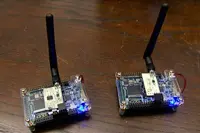 A team of computer scientists and electrical engineers from the University of Washington claims to have generated Wi-Fi transmissions using 10,000 times less power than conventional methods. The Passive Wi-Fi system is also said to consume 1000 times less power than existing energy-efficient wireless communication platforms, such as Bluetooth Low Energy and Zigbee.
A team of computer scientists and electrical engineers from the University of Washington claims to have generated Wi-Fi transmissions using 10,000 times less power than conventional methods. The Passive Wi-Fi system is also said to consume 1000 times less power than existing energy-efficient wireless communication platforms, such as Bluetooth Low Energy and Zigbee.
The team’s Passive Wi-Fi can is claimed to transmit Wi-Fi signals at bit rates of up to 11mbit/s that can be decoded on any of the billions of devices with Wi-Fi connectivity. These speeds are lower than the maximum Wi-Fi speeds but 11 times higher than Bluetooth.
To achieve these low-power Wi-Fi transmissions, the team decoupled the digital and analogue operations involved in radio transmissions. Over the last 20 years, the digital operations have become extremely energy efficient, but the analogue components still consume a lot of power.
The Passive Wi-Fi architecture assigns the analogue, power-intensive functions - like producing a signal at a specific frequency - to a single device in the network that is plugged into the wall.
An array of sensors produces Wi-Fi packets of information using low power by reflecting and absorbing that signal using a digital switch. In real-world test conditions, the team found the passive Wi-Fi sensors and a smartphone can communicate even at distances of 100ft.
"All the networking, heavy-lifting and power-consuming pieces are done by the one plugged-in device," explained co-author Vamsi Talla, an electrical engineering doctoral student. "The passive devices are only reflecting to generate the Wi-Fi packets, which is a really energy-efficient way to communicate."
Because the sensors are creating actual Wi-Fi packets, the researchers say they can communicate with any Wi-Fi enabled device right out of the box without any additional specialised equipment. The technology could enable types of communication that haven't previously been possible because energy demands have outstripped available power supplies.
Joshua Smith, UW associate professor of computer science and engineering and of electrical engineering, concluded: "Now that we can achieve Wi-Fi for tens of microwatts of power and can do much better than both Bluetooth and ZigBee, you could now imagine using Wi-Fi for everything."
The technology has been named one of the 10 breakthrough technologies of 2016 in the MIT Technology Review.
Author
Tom Austin-Morgan
Source: www.newelectronics.co.uk

